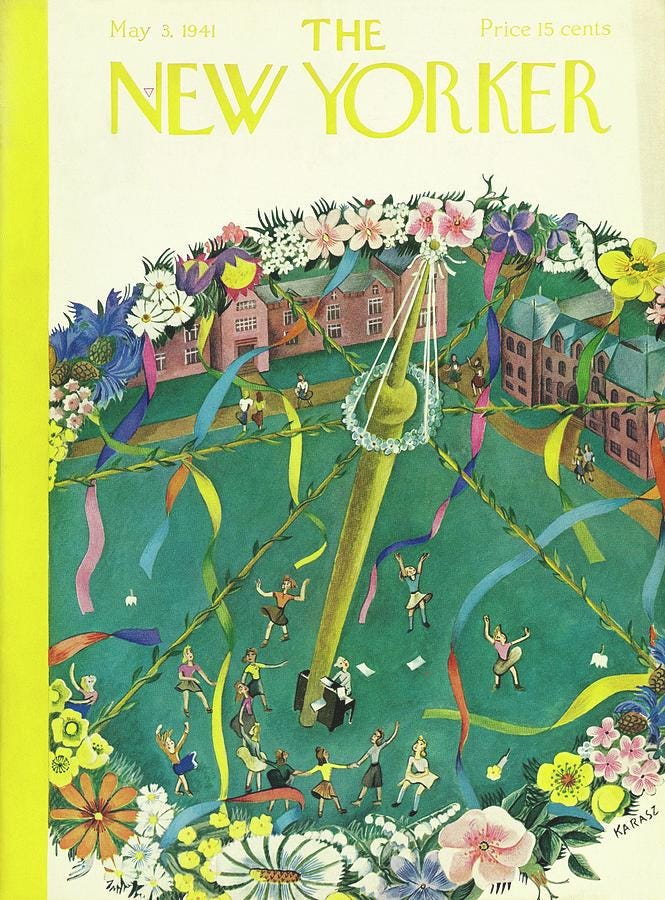Photo: May Day at Holy Comforter Episcopal School, Tallahassee, Florida, 1993
Our teachers never explained May Day to us. There was never a history lesson to rationalize all the flowers and ribbon and the parents out in the playground, squeezed into child-sized chairs, under the full Florida sun, sweating and applauding for each class performance.
We never elected a May Queen at my school, but to my 4, 5, 6, 7, 8 year old self, every 4th and 5th grade girl was as lucky as any princess because she had the privilege of dancing the Maypole.
After years of waiting, my turn came early, in 3rd grade, when I was asked to learn the dance as a substitute - just in case someone didn’t show up for the performance (you have to have an even number of dancers or the weaving does’t work - it’s a very mathematical dance).
It was as magical as I could have hoped.
No one explained May Day to us. But even as a young girl, I had the notion that plaiting ribbon to a pole was very old. Maybe I heard a whisper somewhere that the dance was from England - which made perfect sense to me. We were an Episcopalian school and that meant we were really Anglicans. To my child self, the Maypole was a part of my Episcopal identity.
Later, as a teenager who was just a few key books shy of going Goth, I read about May Day’s roots in the Celtic fertility festival of Beltane. I had to sit and smile at the irony, remembering that every year, my elementary school’s Halloween Carnival was threatened by the complaints of a few Evangelical parents who could not believe a Christian school would celebrate a demonic holiday. But no one ever noticed the phallic symbolism of the Maypole.
From the little that is known about Samhain or Beltane, it makes even less sense to celebrate the latter at a Christian school. But the stars were on my side because the Episcopal Church generally doesn’t care that much about Satanic panic and I got to be the pixie Maypole dancer of my dreams for three years in a row.
Video: May Day Celebrations At Elstow (1939)
I never believed Beltane was demonic. But maybe it was Communist? I remember one sweltering May Day, eavesdropping on two teachers, tucked uncomfortably into those tiny chairs.
“I danced the Maypole when I was a girl too,” one sighed with nostalgia. “It’s a shame it’s dying out.”
“You know,” the other said in a hushed voice. “They say it’s really a Communist thing.”
The first teacher dismissed the comment with a flick of her hand. But my interest had been piqued.
I was born in 1981 and I remember the end of the Cold War clearly. I had a hairbrush that was Made in West Germany. I knew that the Soviets were the bad guys that didn’t want the wall to come down. I asked my mother about what I had heard my teacher say. She had heard the same, but she couldn’t explain to me how May Day and Communism were connected.
“I think the Soviets have a big parade,” was all she could say. What could be so wrong about a big parade, my child self wondered.
And later, when I was an adult who was just a few key books away from becoming an anarchist, I read about the 1886 Haymarket Affair. And I had to sit and ponder the painful irony that International Worker’s Day is celebrated on May 1st to commemorate an American labor tragedy. But we in the U.S. are not allowed to celebrate alongside workers in the 160+ countries where May Day is a public holiday. Our September Labor Day prevents us from celebrating in solidarity with anyone. Most hourly workers don’t even get the day off.
My teacher was right about one thing. May Day really has faded in the U.S. There used to be annual May Day celebrations in Central Park, NYC. And there used to be annual festivities in Lewis Park in my hometown of Tallahassee, Florida. Tallahassee actually had one of the longest standing public May Day traditions in the country. It lasted from 1844 to 1974.
Why did this ritual of spring fade away? Was it demons or Communists or just too old fashioned? Look for Part II of this essay tomorrow. But now, it is almost sun down -meaning, the Feast of Saint Walpurga is almost upon us. One should go light a bonfire or maybe watch a performance of Gounod’s Faust on YouTube. Maybe make a flower crown for your hair. Or look up whatever 50501 is doing in your city tomorrow.
The Worker’s May Pole by English socialist artist Walter Crane, 1894
Did you celebrate May Day when you were young? Do you celebrate it still? Tell me about it in the comments!







I love that you have only been a few key books away from being an anarchist communist Goth 🥰 I wonder what those key books are??
Happy May Day, Heather!